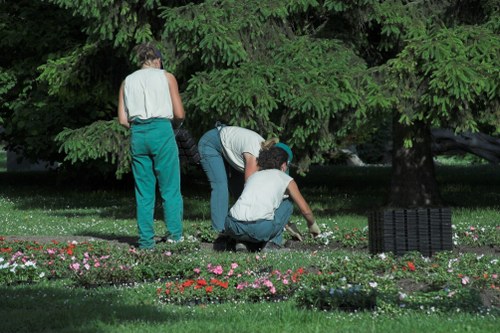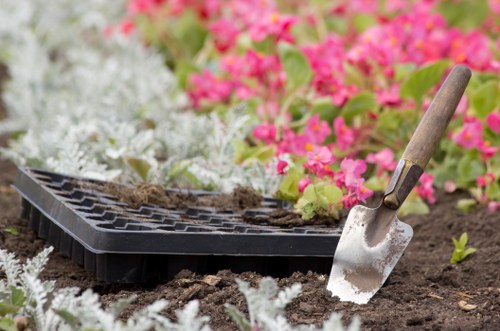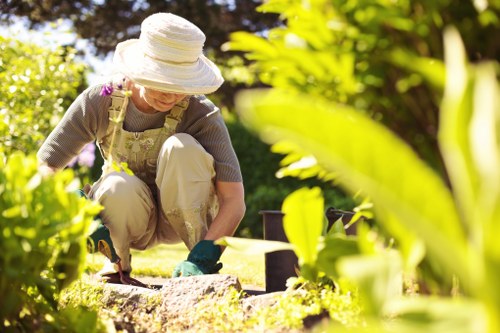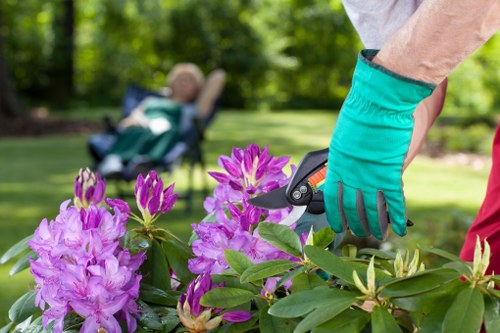Gardener Leaves Green: Achieving Lush, Vibrant Foliage

Maintaining green leaves is essential for any gardener aiming to cultivate a thriving garden. Green leaves are a sign of healthy plants, indicating that they are effectively converting sunlight into energy through photosynthesis. However, achieving and sustaining vibrant green foliage involves understanding various factors that influence plant health.
From soil quality to watering practices, each element plays a crucial role in the overall appearance of your plants. In this article, we will explore the key aspects of keeping leaves green, offering practical tips and solutions to common gardening challenges.
Whether you're a seasoned gardener or just starting out, ensuring your plants have lush, green leaves can enhance the beauty of your garden and contribute to the wellbeing of your plants.

Essential Factors for Healthy Green Leaves
Several essential factors contribute to maintaining green leaves in your garden. Understanding and optimizing these elements can lead to healthier, more vibrant plants.
Sunlight and Its Impact
Sunlight is a critical component for photosynthesis, the process by which plants produce energy. Most plants require adequate sunlight to maintain their green coloration. Insufficient light can lead to pale or yellow leaves, while too much direct sunlight may cause leaf scorch.
To ensure optimal sunlight exposure, research the specific light requirements of your plants. Some may thrive in full sun, while others prefer partial shade. Adjusting the placement of your plants can make a significant difference in their leaf health.
Additionally, consider the time of day and seasonal changes when planning your garden layout. Providing the right balance of light will help your plants maintain their lush green leaves throughout the year.

Watering Practices
Proper watering is essential for maintaining green leaves. Overwatering can lead to root rot and other diseases, while underwatering can cause leaves to wilt and turn brown.
It's important to establish a consistent watering schedule based on the needs of your specific plants. Using techniques such as drip irrigation or soaker hoses can provide a steady supply of moisture without over-saturating the soil.
Additionally, monitoring the soil moisture levels can help you adjust your watering practices as needed. Healthy roots promote strong leaf growth, ensuring your plants stay green and vibrant.

Soil Quality and Nutrition
The quality of your soil directly affects the health of your plants' leaves. Nutrient-rich soil provides the essential elements needed for robust growth and vibrant green foliage.
Regularly testing your soil can help you identify any deficiencies or imbalances in nutrients. Adding organic matter such as compost or well-rotted manure can improve soil fertility and structure, promoting healthier leaves.
In addition to basic nutrients like nitrogen, phosphorus, and potassium, trace minerals play a role in maintaining leaf health. Ensuring a well-balanced nutrient profile will support the overall vitality of your garden.

Best Practices for Maintaining Leaf Greenery
Implementing best practices in your gardening routine can significantly enhance the greenness of your leaves. Here are some effective strategies:
- Regular Pruning: Removing dead or damaged leaves encourages new growth and prevents the spread of diseases.
- Mulching: Applying mulch helps retain soil moisture, regulate temperature, and reduce weed competition.
- Proper Fertilization: Using the right fertilizers at appropriate times ensures your plants receive the nutrients they need.
- Pest Control: Monitoring for pests and taking timely action can prevent infestations that damage leaves.
- Consistent Monitoring: Regularly inspecting your plants allows you to catch and address issues early.
Implementing Integrated Pest Management
Integrated Pest Management (IPM) is a sustainable approach to handling pests that can help maintain green leaves without the overuse of chemicals. IPM involves monitoring pest populations, using biological controls like beneficial insects, and applying treatments only when necessary.
By focusing on prevention and natural solutions, you can protect your plants from pests while preserving the integrity of your garden's ecosystem.
Adopting IPM practices contributes to healthier plants and greener leaves, ensuring a beautiful and resilient garden.
Seasonal Care for Green Leaves
Different seasons present unique challenges and opportunities for maintaining green leaves. Adjusting your care routine according to the season can help keep your plants healthy all year round.
Spring Care
Spring is a time of growth and renewal. As temperatures rise and daylight increases, it's essential to prepare your plants for the upcoming growing season.
Start by fertilizing your soil to provide a nutrient boost. Regular watering and monitoring for early signs of pests or diseases can set the stage for robust leaf growth.
Pruning and trimming also help shape your plants and remove any winter damage.
Summer Maintenance
During the summer months, plants may face heat stress and increased watering needs. Ensuring adequate moisture is crucial, but be mindful to avoid overwatering.
Providing shade or using mulch can help retain soil moisture and protect leaves from scorching sunlight.
Regularly check for pests and diseases, as the warm weather can accelerate their spread.
Autumn Strategies
As temperatures cool, plants transition from active growth to preparing for dormancy. This is an ideal time to reinforce soil health by adding compost and other organic matter.
Pruning should focus on removing spent growth and shaping plants for the winter. Protecting leaves from frost by covering sensitive plants can prevent damage.
Adjusting your watering schedule to account for reduced evaporation ensures that plants receive enough moisture without overwatering.
Winter Protection
In winter, maintaining green leaves can be challenging due to cold temperatures and reduced sunlight. Protecting plants from harsh conditions is essential.
Use covers or mulches to insulate the soil and protect roots from freezing. Selecting cold-tolerant plant varieties can also help ensure your garden remains vibrant.
Minimizing pruning during winter prevents unnecessary stress on plants, allowing them to conserve energy for the next growing season.
Organic Solutions for Leaf Health
Opting for organic gardening practices supports the health of your plants and the environment. Organic solutions can effectively maintain green leaves without the use of harsh chemicals.
Composting
Composting recycles kitchen and garden waste into nutrient-rich soil amendments. Adding compost improves soil structure, enhances fertility, and promotes healthy leaf growth.
Natural Fertilizers
Using natural fertilizers like bone meal, fish emulsion, and seaweed extract provides essential nutrients without the risk of chemical buildup.
Beneficial Insects
Introducing beneficial insects such as ladybugs and predatory mites can help control pest populations naturally, protecting your leaves from damage.
Common Problems and Solutions
Despite best efforts, gardeners may encounter issues that affect the greenness of their leaves. Recognizing and addressing these problems promptly is key to maintaining a healthy garden.
Identifying Leaf Yellowing
Yellowing leaves can indicate various issues, including nutrient deficiencies, overwatering, or pest infestations. Identifying the underlying cause is essential for effective treatment.
For instance, nitrogen deficiency often results in overall yellowing, while specific patterns can point to other problems like root issues or environmental stress.
Adjusting your care routine based on the symptoms can restore the vibrant green of your leaves.
Pests That Affect Leaf Greenery
Pests such as aphids, spider mites, and caterpillars can damage leaves, leading to discoloration and reduced plant health. Monitoring your plants regularly helps detect infestations early.
Using organic pest control methods, such as introducing beneficial insects or applying neem oil, can manage pest populations without harming your plants or the environment.
Preventative Measures
Implementing preventative measures like maintaining plant health, avoiding overcrowding, and practicing crop rotation can reduce the likelihood of pest problems.
Local Areas Near Leaves Green for Gardening Enthusiasts
If you reside near Leaves Green, there are several nearby areas that offer excellent opportunities for gardening enthusiasts. These areas provide unique features that cater to different gardening needs and preferences.
- Greenwood Park: Located just 2 miles from Leaves Green, Greenwood Park offers expansive community gardens and a variety of plant species ideal for local gardeners.
- Sunnyvale Gardens: 3 miles away, Sunnyvale Gardens is known for its well-maintained public green spaces and gardening workshops.
- Maplewood Nursery: Situated 1.5 miles from Leaves Green, Maplewood Nursery provides a wide selection of plants, tools, and expert gardening advice.
- Elm Street Arboretum: 4 miles from Leaves Green, this arboretum features extensive collections of trees and shrubs, perfect for inspiration and study.
- Riverbend Farms: Located 5 miles away, Riverbend Farms offers community-supported agriculture (CSA) programs and seasonal planting events.
- Oak Hill Gardens: 2.5 miles from Leaves Green, Oak Hill Gardens is a popular spot for plant enthusiasts seeking diverse plant varieties and gardening resources.
- Pinecrest Community Garden: Just 3 miles away, Pinecrest Community Garden encourages local participation and offers plots for individual gardeners.
- Willow Creek Botanical: 4.5 miles from Leaves Green, Willow Creek Botanical specializes in native plant species and sustainable gardening practices.
- Cedar Grove Greenhouses: Located 6 miles away, Cedar Grove Greenhouses provide year-round gardening options and a variety of greenhouse plants.
- Birchwood Park: 2 miles from Leaves Green, Birchwood Park features ornamental gardens and educational programs for gardeners of all levels.
- Fern Valley: Situated 3.5 miles away, Fern Valley is renowned for its lush, shaded areas and ferns, catering to gardeners interested in shade-loving plants.
- Lakeview Gardens: 5.5 miles from Leaves Green, Lakeview Gardens combines water features with floral displays, offering a tranquil environment for gardening enthusiasts.
- Rosewood Park: Just 1 mile from Leaves Green, Rosewood Park is famous for its rose gardens and annual flower festivals.
- Sunset Orchards: Located 4 miles away, Sunset Orchards specializes in fruit-bearing plants and provides resources for fruit gardening.
Frequently Asked Questions
1. How much sunlight do plants need to keep their leaves green?
The amount of sunlight required varies by plant species. Generally, most plants thrive in full sun (6-8 hours of direct sunlight), while others prefer partial shade. It's essential to research the specific light needs of your plants to ensure optimal leaf health.
2. What are common signs of overwatering in plants?
Common signs of overwatering include yellowing leaves, wilting despite moist soil, and root rot. If you notice these symptoms, adjust your watering practices by allowing the soil to dry out between waterings and improving drainage.
3. How can I improve soil quality for greener leaves?
Improving soil quality can be achieved by adding organic matter such as compost or aged manure. These amendments enhance soil fertility, structure, and moisture retention, providing a better environment for plant roots and promoting vibrant green leaves.
4. What natural methods can I use to control pests that affect leaf health?
Natural pest control methods include introducing beneficial insects like ladybugs, using neem oil or insecticidal soap, and implementing crop rotation. These approaches help manage pest populations without the use of harmful chemicals.
5. Are there specific fertilizers that help maintain green leaves?
Yes, fertilizers high in nitrogen, such as fish emulsion or blood meal, promote lush, green foliage. It's important to follow recommended application rates to avoid nutrient imbalances that can harm your plants.